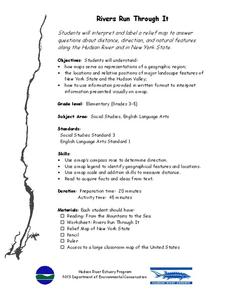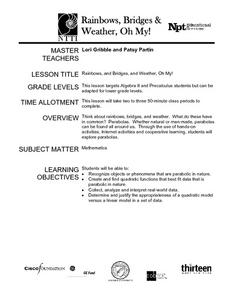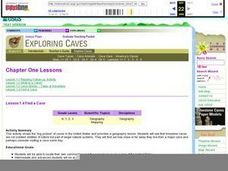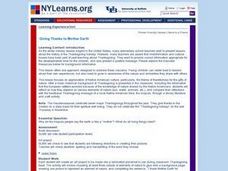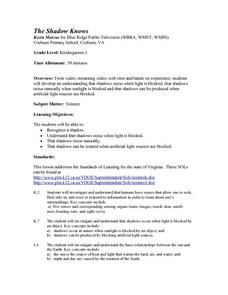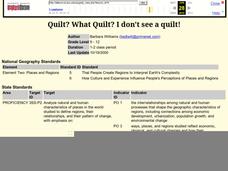Curated OER
Rivers Run Through It
Using a relief map of New York State, learners answer questions about the distance between different cities, identify bodies of water, and more. First, they discuss vocabulary related to the Hudson River area. Then, they complete a...
Curated OER
Rainbows, Bridges & Weather, Oh My!
Explore how real-world applications can be parabolic in nature and how to find quadratic functions that best fit data. A number of different examples of modeling parabolas are explored including a student scavenger hunt, the exploration...
Curated OER
Then and Now, A Watershed in San Francisco
Young scholars compare recent and historic maps to explore landscape changes. Using photos provided, students identify prominent features on the maps. They discuss differences in landscape, human impact on watershed, and changes in...
Curated OER
Find a Cave
Students locate their own communites and the nearest caves on a United States map. They calculate the distance to the nearest cave using rough scale.
Curated OER
Exploring Idaho
For this exploring Idaho worksheet, 4th graders complete ten multiple choice statements about interesting places in the state of Idaho.
Curated OER
Class of Gold
How can you see a number in nature? Here, learners discover both Fibonacci numbers and the golden ratio by exploring a number of different resources. Note: Some of the resources are older and may be missing some of the links, but...
Curated OER
Northwest Hawaiian Islands
Students compare and contrast places around the world. Students analyze the effects of human activity on the physical environment and devise plans to address the consequences. Students also focus on geographical topics such as formation...
Curated OER
The Case of the "Lost Gorge:
Students examine the case of a map making expedition. In groups, they read a case study on "The Lost Gorge" in the Finger Lakes region of New York state. They examine maps and determine where the error in the map-making occured to end...
University of Wisconsin
A Rain Garden Year
Pupils become plants in an interpretive play that depicts what happens throughout the seasons in a rain garden. As you narrate, young scholars bloom, flower, and go to seed accordingly. The instructional activity is first in a series of...
Curated OER
Giving Thanks to Mother Earth
Students create an art project to be made into a laminated placemat to use during a classroom Thanksgiving feast. The lesson plan involves choosing at least three cutouts of elements of nature to glue onto a background page, drawing one...
Curated OER
Integrative Lesson on Genres of American Literature (Senior, Literature)
To begin this lesson, the instructor will present a PowerPoint detailing the genres of Romanticism, Realism, and Naturalism. Learners will follow along with an instructional sheet that will aid in the identification of setting, tone,...
Curated OER
The Importance of Representative Democracy
Students examine the general concept of representative democracy, and compare/contrast the American representative democracy to the monarchical system. They research the role of legislative bodies in serving the government, particularly...
Curated OER
The Shadow Knows - Creating Shadows
Young learners recognize a shadow and witness how shadows occur when light is blocked. They access streamed video, standard video, and websites in order to engage in their study of how light is naturally blocked to create shadows. An...
Curated OER
Goldsworthy Project: Building With the Five Elements of Art
Seventh graders explore the five elements of art: line, shape, value, texture and color. They collect items from nature and arrange them aesthetically taking the five elements into consideration. They consider their work from several...
Curated OER
Air Pollution
Students seek solutions to environmental problems. They discover how to conserve and protect natural resources. They examine the role of acid rain on plants and discover how to filter pollutants.
Curated OER
Balance in Visual Art
Students examine works of art to develop an understanding of the importance of visual balance in works of art and nature. Students research artists and their artwork for examples of visual balance. Students create works of art showing...
Curated OER
Honu Survivor: The Green Sea Turtle Experience
Students participate in discussions and role-play to learn the hardships of baby Green Sea Turtles. They explore the low survival rate due to natural predators and man.
Curated OER
Habitats: must live with them....cannot live without them.
Students conduct an internet study regarding habitat, ecosystem, biome and the region they live in. They observe the habitat by visiting a State Park and observing the organisms in their habitat. In addition, they create their own...
Curated OER
Quilt? What Quilt? I Don't See a Quilt!
Students analyze maps and cultures of major cities in the state of Arizona and designate different regions within the state according to geography and economy.
Curated OER
The Causes of Prohibition
Eleventh graders explore the origins of the Prohibition Movement in the United States. In small groups, they analyze the influence of World War I in the passage of the eighteenth amendment. Students explain how different demographics of...
Curated OER
U.S. and Canada: How are We the Same? How are We Different?
Get high school geographers to compare and contrast Canada and the United States. They begin by drawing a freehand map of North America, then complete readings to gain insight into Canada. The text is not provided; however, another text...
Curated OER
Utah Crossword
In this Utah activity, students explore the state of Utah. Students must complete the crossword puzzle by coming up with the answers to the ten clues given.
Curated OER
1900 America: Primary Sources and Epic Poetry
Using Walt Whitman's Song of Myself and Hart Crane's The Bridge as models, class groups first craft their own epic poems for 1900 and, using primary sources, create a multi-media presentation that captures the sights and...
Curated OER
Trembling, Spewing Earth: Impacts on Human Activity
Seventh graders study to identify patterns in earthquake activity and impacts on human behavior. They also develop plans to cope with such natural disasters.
